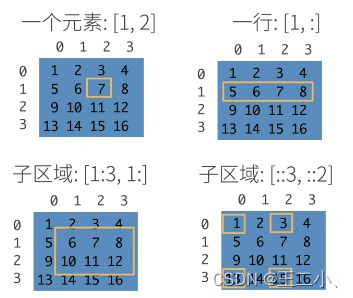一 动手学深度学习v2笔记 —— 深度学习介绍及数据操作预处理
第一天 动手学深度学习v2 —— 深度学习介绍及数据操作
-
- 预告
- 01 课程安排
-
- 目标
- 内容
- 02 深度学习介绍
- 03 安装
- 04 数据操作 + 数据预处理
-
- 一、 数据操作
- 二、数据操作实现
- 三、数据预处理实现
目录:
- 预告
- 课程安排
- 深度学习介绍
- 安装
- 数据操作
- 数据预处理
预告
- 教材 https://zh-v2.d2l.ai/
- 源代码 https://github.com/d2l-ai/d2l-zh
- 课程主页 https://courses.d2l.ai/zh-v2/
- 课程论坛讨论 https://discuss.d2l.ai/c/16
- Pytorch论坛 https://discuss.pytorch.org
01 课程安排
目标
- 介绍深度学习经典和最新模型
- LeNet, ResNet, LSTM, BERT,…
- 机器学习基础
- 损失函数, 目标函数, 过拟合, 优化
- 实践
- 使用pytorch实现介绍的知识点
- 在真实数据上体验算法效果
内容
- 深度学习基础 - 线性神经网络,多层感知机
- 卷及神经网络 - LeNet,AlexNet,VGG,Inception,ResNet
- 循环神经网络 - RNN,GRU,LSTM,seq2seq
- 注意力机制 - Attention,Transformer
- 优化算法 - SGD,Momentum,Adam
- 高性能计算 - 并行,多GPU,分布式
- 计算机视觉 - 目标检测,语义分割
- 自然语言处理 - 词嵌入,BERT
02 深度学习介绍
03 安装
04 数据操作 + 数据预处理
一、 数据操作
1. N维数组是机器学习和神经网络的主要数据结构
- 创建数组需要
- 形状
- 每个元素的数据类型
- 每个元素的值
3. 访问数组
二、数据操作实现
张量表示一个数值组成的数组,这个数组可能有多个维度
x = torch.arange(12)
print(x)
tensor([ 0, 1, 2, 3, 4, 5, 6, 7, 8, 9, 10, 11])
我们可以通过shape属性来访问张量的形状和张量中元素的总数
print(x.shape)
print(x.numel())
torch.Size([12])
12
要改变一个张量的形状而不改变元素数量和元素值,可以调用 reshape 函数
X = x.reshape(3, 4) # y,x
print(X)
tensor([[ 0, 1, 2, 3],
[ 4, 5, 6, 7],
[ 8, 9, 10, 11]])
使用全0、全1、其他常量或者从特定分布中随机采样的数字
print(torch.zeros((2, 3, 4)))
print(torch.ones((2, 3, 4)))
tensor([[[0., 0., 0., 0.],
[0., 0., 0., 0.],
[0., 0., 0., 0.]],
[[0., 0., 0., 0.],
[0., 0., 0., 0.],
[0., 0., 0., 0.]]])
tensor([[[1., 1., 1., 1.],
[1., 1., 1., 1.],
[1., 1., 1., 1.]],
[[1., 1., 1., 1.],
[1., 1., 1., 1.],
[1., 1., 1., 1.]]])
通过提供包含数值的 Python 列表(或嵌套列表)来为所需张量中的每个元素赋予确定值
print(torch.tensor([[[2, 1, 4, 3],
[1, 2, 3, 4],
[4, 3, 2, 1]]]))
print(torch.tensor([[[2, 1, 4, 3],
[1, 2, 3, 4],
[4, 3, 2, 1]]]).shape)
tensor([[[2, 1, 4, 3],
[1, 2, 3, 4],
[4, 3, 2, 1]]])
torch.Size([1, 3, 4])
常见的标准算术运算符(+、-、*、/ 和 **)都可以被升级为按元素运算
x = torch.tensor([1.0, 2, 4, 8])
y = torch.tensor([2, 2, 2, 2])
print(x + y)
print(x - y)
print(x * y)
print(x / y)
print(x ** y)
tensor([ 3., 4., 6., 10.])
tensor([-1., 0., 2., 6.])
tensor([ 2., 4., 8., 16.])
tensor([0.5000, 1.0000, 2.0000, 4.0000])
tensor([ 1., 4., 16., 64.])
按元素方式应用更多的计算
print(torch.exp(x))
tensor([2.7183e+00, 7.3891e+00, 5.4598e+01, 2.9810e+03])
我们也可以把多个张量 连结(concatenate) 在一起
X = torch.arange(12, dtype=torch.float32).reshape((3, 4))
Y = torch.tensor([[2.0, 1, 4, 3], [1, 2, 3, 4], [4, 3, 2, 1]])
torch.cat((X, Y), dim=0), torch.cat((X, Y), dim=1)
(tensor([[ 0., 1., 2., 3.],
[ 4., 5., 6., 7.],
[ 8., 9., 10., 11.],
[ 2., 1., 4., 3.],
[ 1., 2., 3., 4.],
[ 4., 3., 2., 1.]]),
tensor([[ 0., 1., 2., 3., 2., 1., 4., 3.],
[ 4., 5., 6., 7., 1., 2., 3., 4.],
[ 8., 9., 10., 11., 4., 3., 2., 1.]]))
通过 逻辑运算符 构建二元张量
print(X == Y)
tensor([[False, True, False, True],
[False, False, False, False],
[False, False, False, False]])
对张量中的所有元素进行求和会产生一个只有一个元素的张量
print(torch.sum(X))
print(X.sum())
tensor(66.)
tensor(66.)
即使形状不同,我们仍然可以通过调用 广播机制 (broadcasting mechanism) 来执行按元素操作
a = torch.arange(3).reshape(3, 1)
b = torch.arange(2).reshape(1, 2)
print(a, '\n', b)
print(a + b)
tensor([[0],
[1],
[2]])
tensor([[0, 1]])
tensor([[0, 1],
[1, 2],
[2, 3]])
可以用 [-1] 选择最后一个元素,可以用 [1:3] 选择第二个和第三个元素
print(X[-1])
print(X[1: 3])
tensor([ 8., 9., 10., 11.])
tensor([[ 4., 5., 6., 7.],
[ 8., 9., 10., 11.]])
除读取外,我们还可以通过指定索引来将元素写入矩阵
X[1, 2] = 9
print(X)
tensor([[ 0., 1., 2., 3.],
[ 4., 5., 9., 7.],
[ 8., 9., 10., 11.]])
为多个元素赋值相同的值,我们只需要索引所有元素,然后为它们赋值
X[0:2, :] = 12
print(X)
tensor([[12., 12., 12., 12.],
[12., 12., 12., 12.],
[ 8., 9., 10., 11.]])
运行一些操作可能会导致为新结果分配内存
before = id(Y)
Y = Y + X
print(id(Y) == before)
False
执行原地操作
print('id(Y):', id(Y))
Y[:] = Y + X
print('id(Y):', id(Y))
Z = torch.zeros_like(Y)
print('id(Z):', id(Z))
Z[:] = X + Y
print('id(Z):', id(Z))
id(Y): 140027489362712
id(Y): 140027489362712
id(Z): 140027489340152
id(Z): 140027489340152
如果在后续计算中没有重复使用 X,我们也可以使用 X[:] = X + Y 或 X += Y 来减少操作的内存开销
before = id(X)
X += Y
print(id(X) == before)
True
转换为 NumPy 张量
A = X.numpy()
B = torch.tensor(A)
print(type(A), '\n', type(B))
将大小为1的张量转换为 Python 标量
a = torch.tensor([3.5])
print(a, '\n', a.item(), '\n', float(a), '\n', int(a))
tensor([3.5000])
3.5
3.5
3
三、数据预处理实现
创建一个人工数据集,并存储在csv(逗号分隔值)文件
import os
os.makedirs(os.path.join('.', 'data'), exist_ok=True)
data_file = os.path.join('.', 'data', 'house_tiny.csv')
with open(data_file, 'w') as f:
f.write('NumRooms,Alley,Price\n')
f.write('NA,Pave,127500\n')
f.write('2,NA,106000\n')
f.write('4,NA,178100\n')
f.write('NA,NA,140000\n')
从创建的csv文件中加载原始数据集
import pandas as pd
data = pd.read_csv(data_file)
print(data)
NumRooms Alley Price
0 NaN Pave 127500
1 2.0 NaN 106000
2 4.0 NaN 178100
3 NaN NaN 140000
为了处理缺失的数据,典型的方法包括插值和删除, 这里,我们将考虑插值
inputs, outputs = data.iloc[:, 0:2], data.iloc[:, 2]
print('inputs: \n', inputs)
print('outputs: \n', outputs)
inputs = inputs.fillna(inputs.mean())
print('inputs: \n', inputs)
inputs:
NumRooms Alley
0 NaN Pave
1 2.0 NaN
2 4.0 NaN
3 NaN NaN
outputs:
0 127500
1 106000
2 178100
3 140000
Name: Price, dtype: int64
inputs:
NumRooms Alley
0 3.0 Pave
1 2.0 NaN
2 4.0 NaN
3 3.0 NaN
对于inputs中的类别值或离散值,我们将“NaN”视为一个类别
inputs = pd.get_dummies(inputs, dummy_na=True)
print(inputs)
NumRooms Alley_Pave Alley_nan
0 3.0 1 0
1 2.0 0 1
2 4.0 0 1
3 3.0 0 1
现在inputs和outputs中的所有条目都是数值类型,它们可以转换为张量格式
import torch
X, y = torch.tensor(inputs.values), torch.tensor(outputs.values)
print('X: \n', X)
print('y: \n', y)
X:
tensor([[3., 1., 0.],
[2., 0., 1.],
[4., 0., 1.],
[3., 0., 1.]], dtype=torch.float64)
y:
tensor([127500, 106000, 178100, 140000])


